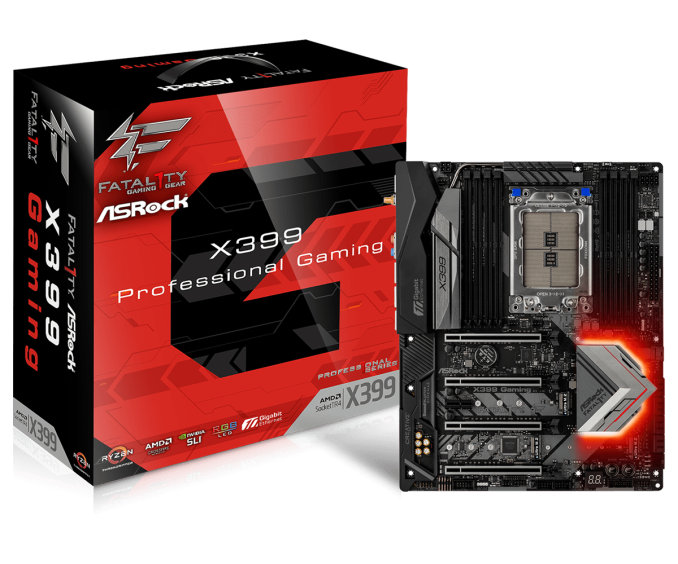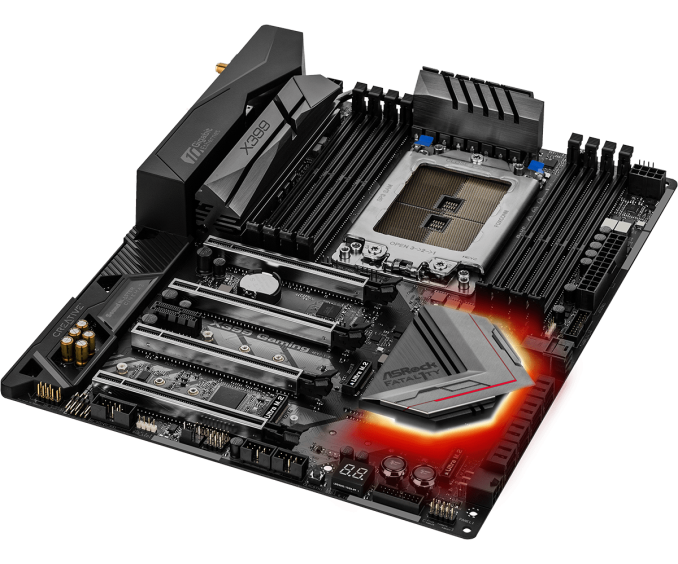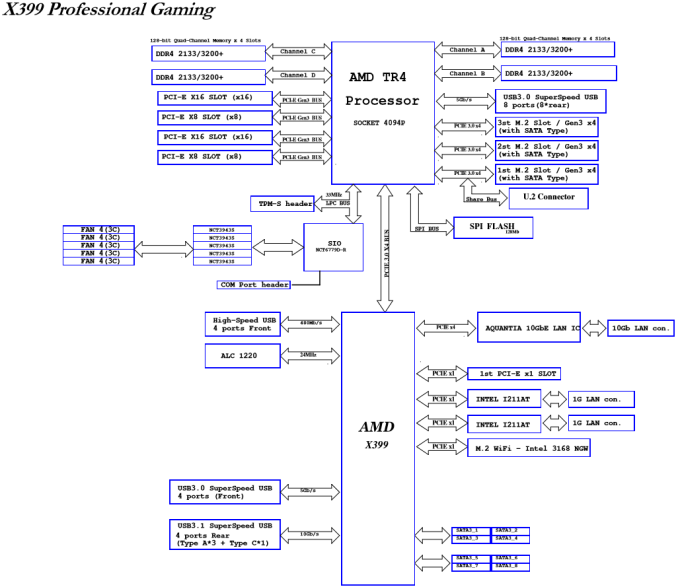An AMD Threadripper X399 Motherboard Overview: A Quick Look at Seven Products
by Ian Cutress & Joe Shields on September 15, 2017 9:00 AM ESTASRock
No stranger to the fray, ASRock is ready with the launch of two boards, the X399 Professional Gaming and X399 Taichi. Both boards share features but have enough differences to separate them in the product stack. The Pro Gaming adds 10 Gigabit Ethernet to its two Gigabit NICs and supports Creative Sound Blaster Cinema 3, while the Taichi aims to be a more mid-range board, by sticking with dual Gigabit NICs and uses Purity Sound 4. The styling is a little different too.
ASRock X399 Professional Gaming
The high-end board from ASRock will be the Professional Gaming. It also carries the Fatal1ty name, due to ASRock’s never-ending association with a pro-gamer from the turn of the century.
On the aesthetic side, the X399 Professional Gaming has a black PCB accented with gray heatsinks and grey stenciling where the M.2 slots are located. The memory slots are black, along with the rear IO cover that extends down the board. There are two heatsinks to cool the VRMs, connected by a heatpipe, and one reaches near to the rear IO. The chipset heatsink is not connected as part of the VRM cooling, but consumes a fairly large portion of the board and looks a bit like a play button. As with the fascination with RGB, the Professional Gaming has a few under the chipset heatsink. Users can add more RGB LEDs via two headers, and control them all through ASRock's RGB LED application.
The Professional Gaming has support for both NVIDIA 4-Way SLI and AMD 4-Way Crossfire with full-length PCIe slots. These have additional reinforcement to prevent sag or bending due to heavy PCIe cards during transit – the reinforcement is what ASRock calls its ‘Steel Armor’. The PCIe slots give an x16/x8/x16/x8 configuration from top to bottom, using 48 of the 60 PCIe lanes from the processor. The rest of the lanes are allocated to storage: there are a total of three M.2 PCIe 3.0 x4 slots, one of which is shared/switched with a U.2 connector. For other storage, there are eight SATA ports from the chipset that natively support RAID 0/1/10.
For added features, the X399 Professional Gaming jumps past the ever-present Gigabit Ethernet and uses an Aquantia AQC107 10 Gigabit LAN controller to appeal to users that want to invest in 10GbE. This is paired with two Intel I211AT network controllers, and all three can do regular gigabit Ethernet duties. If three Ethernet ports were not enough, also included is an integrated Intel AC8265 2x2 802.11a/b/g/n/ac WiFi module, to handle wireless duties.
ASRock provided chipset diagram for the Pro Gaming to show how it breaks down all the bandwidth:
For power delivery, ASRock uses a digital 11 phase International Rectifier solution, along with IR DrMOS for monitoring VRM current and temperature. Distributing power to the VRMs are two EPS 12V connectors, an 8-pin and a 4-pin, although the system will work with only the 8-pin installed. Typically we see EPS connectors oriented close to each other at the top of the motherboard, but here the connectors are located on opposite sides of the socket. As shown above, the 8-pin is in the upper right-hand corner above the DIMM slots, while the supplemental 4-pin is in the more familiar location at the top left-hand corner. ASRock asserts this creates a wider trace for the CPU VRM, bringing better power delivery efficiency and lowering temperatures.
For USB connectivity, the Professional Gaming has three USB 3.1 (10 Gbps) Type-A ports on the rear, one USB 3.1 (10 Gbps) Type-C port on the rear, two USB 3.1 (5 Gbps) headers for front panel ports, and two USB 2.0 headers for front panel ports.
| Fatal1ty X399 Professional Gaming | |
| Warranty Period | 3 Years |
| Product Page | Link |
| Price | $439.99 |
| Size | ATX |
| CPU Interface | TR4 |
| Chipset | AMD X399 |
| Memory Slots (DDR4) | Eight DDR4 Slots, up to 3600 MT/s Supporting 128GB Quad Channel |
| Network Connectivity | 1 x Aquantia AQC107 10 Gigabit LAN 2 x Intel I211AT GbE |
| Wireless Network | 802.11 ab/g/n/ac Dual-Band (2.4/5 GHz) Bluetooth 4.2 |
| Onboard Audio | Realtek ALC1220 |
| PCIe Slots | 4 x PCIe 3.0 (x16/x8/x16/x8) from CPU 2 x PCIe 2.0 x1 from Chipset |
| Onboard SATA | 8 x SATA 6 Gbps Supporting RAID 0/1/5/10 |
| Onboard SATA Express | None |
| Onboard M.2 | 3 x PCIe 3.0 x4 - NVMe or SATA |
| Onboard U.2 | 1 x PCIe 3.0 x4 (disables M2_1 when in use) |
| USB 3.1 | 1 x Type-A , 1 x Type-C (Rear Panel) |
| USB 3.0 | 8 x Rear Panel, 4 x via internal headers |
| USB 2.0 | 4 x via internal headers |
| Power Connectors | 1 x 24-pin ATX 1 x 8-pin CPU 1 x 4-pin CPU |
| Fan Headers | 1 x CPU 1A/12W Max. (4-pin) 1 x CPU Opt/Water Pump 1.5A/18W Max. (4-pin) 2 x Chassis (4-pin) 1 x Chassis Opt/Water Pump 1.(4-pin) |
| IO Panel | 2 x Antenna Ports 1 x PS/2 Mouse/Keyboard Port 1 x Optical SPDIF Out Port 1 x USB 3.1 Type-A Port (10 Gb/s) 1 x USB 3.1 Type-C Port (10 Gb/s) 8 x USB 3.0 Ports 4 x USB 3.0 Ports 3 x RJ-45 LAN Ports w/ LED 1 x BIOS Flashback Switch HD Audio Jacks |
















99 Comments
View All Comments
LordanSS - Saturday, September 16, 2017 - link
My money is on the latter.... =/vgray35@hotmail.com - Friday, September 15, 2017 - link
With CPU power approaching 150 Amps, all these MBs are brain dead right out the gate, for using 50y old 8+ phase Buck converter topology, where VRMs with multiple phases still have poor response settling times (not one cycle settling but 20 cycles), lowish efficiencies way below 98% needing substantial heat sinks; while being saddled with the vagaries of inductive energy storage which takes up a lot of space and cost much more. Instead they should be using hybrid-PWM switching eliminating hard switch of high currents, where fractional cycle resonance ensures zero current switching and almost no switching losses. Resonance frequency scaling of the inductor/capacitor eliminates the need for ferrite cores altogether, reducing both size and core losses.http://www.powerelectronics.com/power-management/s...
Rehashing the same old power technologies with only stepwise minuscule improvements at each iteration, is not going to bode well at all. These engineers need to join the rest of us in the 21st century, and stop rehashing inductive energy storage solutions in power supplies. These new power topologies have been available for 5y to 8y now. And further this will also reduce EMI noise.
vgray35@hotmail.com - Friday, September 15, 2017 - link
I might add eliminating the multi-phase Buck converters for a solution based on PWM-resonance switching (hybrid switching), fractional cycle resonance (one cycle settling responses), and resonance scaling of resonance components, will likely permit a X399 mITX board to be made; with all that PSU space recovered for other purposes. Who will take up the challenge? AMD, ASROCK? Or will Intel beat AMD in the rush to high current capability at 99% efficiency? Or one of the other competitors out there! A clarion call to action this is to once and for all retire the Buck converter!ddriver - Friday, September 15, 2017 - link
I doubt they will even make a micro atx board, much less itx...It will be a waste, gigantic socket will take up most of the space, there won't be enough room for all 4 memory channels, the CPUs generous amount of PCIE lanes will be utterly wasted.
vgray35@hotmail.com - Friday, September 15, 2017 - link
Yes, and yet ASROCK put the X99 on a mITX board. However cutting heat from the VRM's by 60% to 70% or more should be done anyway, not to mention the graphics cards that draw even more power. Why settle for 95/96% efficiency (or worse in some cases) when one could get 98.5% to 99% efficiency. But then again you might be right concerning Thread Ripper, although I would still buy it with M2 slots on the back. The power delivery could be moved entirely to the back of the board without heat sinks with a total height of only 1.5mm (possibly at the center of socket itself on the back). The challenge of course is just as applicable to the graphics cards.ddriver - Saturday, September 16, 2017 - link
Hm, it seems that they launched some lga2066 boards recently, an asrock itx and an msi matx. TR4 however is still atx and up only...DanNeely - Friday, September 15, 2017 - link
I agree about how little sense it would make; but there have been a few LGA2011 mITX boards for people who only needed the higher core count. One of the two currently listed on Newegg uses SoDIMMs and riser boards around the CPU socket to make everything fit. Doing it for Threadripper would definitely be harder on account of the bigger socket; but I won't say never.Xajel - Saturday, September 16, 2017 - link
mITX is very hard even with riser boards & only 4x SO-DIMMsbut mATX on the other hand is very plausible... lets hope for a mATX version of the ASRock Pro Gaming with it's 10GbE ( and at least one of it's Intel's 1GbE ), at least 2 of it's M.2's and 6+ SATA ports... and please ASRock, add a front USB 3.1g2 header...
ddriver - Friday, September 15, 2017 - link
Amps, or amperes, is a unit of current, not a unit of power. Power is measured in watts."Rehashing the same old power technologies with only stepwise minuscule improvements at each iteration, is not going to bode well at all." - this is unfortunately a fact, and the de-fact motto of the industry.
ddriver - Friday, September 15, 2017 - link
I mean it is kinda naive to assume several years old switching circuits will find their way into the mainstream just because they are a few percent better.We've had gas turbine engines for decades, but they are still only used in tanks, helicopters or naval ships, while mainstream vehicles are still stuck with the internal combustion engine, which is easier to break, harder to maintain and a whooping 60% less efficient.